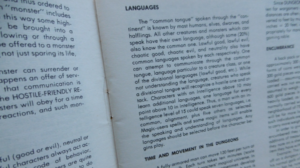In his Letter from the Editor (L’avant garde #46, June 1982), Steve Ruskin introduces the following article with a backhanded compliment:
“And it looks like our young friends of the Pandemonium Society are progressing (or regressing) into wargaming. This time Phenster & Co. have dug up Gygax’s pole arms treatise to field a phalanx formation. I don’t recall that anyone in the [East Middleton Wargamers] Association has tried to do such a thing at man-to-man scale. Points to the kids for this admirable attempt. Typical for Phenster’s contributions, I’m sure there are useful rules in there somewhere. Up to you to figure them out.”
Phalanx Fighting
Ivanhoe gave us some old copies of Strategic Review, which is about D&D and some other stuff, like wargames. Ivanhoe said it's like Dragon magazine but from a long time ago. We found some articles about spears and pole arms, and Cypher looked it up in the set of encyclopedias she has at home, as she likes to do. She wrote a book report about what all she found out, and we added it to Cypher's Codex, which is a 3-ring binder we keep with all her research in it.
Spears
A normal spear is from 6 to 9 feet long. You can throw it as a missile weapon or use it hand-to-hand by thrusting it at your opponent. A long spear is between 9 and 15 feet. It's too long to throw, but with a spear at least 8 ft. long, you can attack an opponent from behind a rank of allies (which you can do with any pole arm, including halberds). A 12-ft. long spear can reach through 2 ranks of fighters.
Pikes
A pike is a spear 15 feet long or even longer. It can reach through 3 or more ranks of fighters. We can't take pikes into the dungeon, usually. Hazard's rule of thumb is that we can use weapons equal in length to the dungeon's regular ceiling height or less but no longer. We tried it one time. We had 12-ft. long spears in a dungeon with ceilings 10 ft. high. They slowed us down, and we made a lot of noise. Then, when a bunch of goblins attacked us (because of all the noise) from the side corridor, we couldn't even get the spearmen into position to defend our flank.
Phalanx
We arm men-at-arms with plate mail (when we can afford it) and shields with spears and short swords. We put them in 3 ranks, 4 across, in a 10-ft. hallway. When we meet monsters, the 1st rank throws their spears if they have time. If not--like when we're surprised--they drop their spears and draw their swords. Once we're closed for melee, the 1st rank fights with short sword and the 2nd rank attacks with their spears. The 3rd rank replaces any wounded or killed in action.
If we go into a room or a wider corridor, the ranks can spread out to fill a 20' wide front (that's 5' per man) or change to a formation 2 ranks x 6 men, 30 feet wide. In close order (2 and a half ft. per man), you can't swing a sword. You have to use a short, thrusting weapon, like a short sword or a dagger.
(A sword needs at least 3' to use effectively. Most other big weapons, for example, a battle axe or a morning star, need at least 5'.)
When we're outside, exploring the wilderness or fighting a big battle for example (not in the dungeon), we can have many ranks (up to 10 or even 20) in a phalanx. We put missile weapons (javelins, slings, bows) behind the phalanx to fire over their heads at the enemy not in melee. But we have to protect the flanks with other troops (cavalry is best), because the phalanx doesn't maneuver very quickly.
Charging
A phalanx can charge, but it only moves 50% faster than normal. A spearman (or any armored fighter) gets a +1 bonus on damage due to momentum. If you attack a charging opponent with a spear, you get a +1 bonus on damage. You can also "set the spear" (brace it against a wall or the floor) against a charging opponent. Then you get +2 on damage.
Shield Wall
Another thing we like to do in a phalanx is make a shield wall. Short swords or normal spears only, because long spears need two hands to hold. When you make a shield wall, each man-at-arms stands shoulder to shoulder in close order formation. The front rank holds their shields so they overlap. A shield usually gives you 1 better armor class, but in a shield wall you get +2, except for the man on the right end. Ranks behind the front can hold their shields over their heads against missile fire attacks.
With a shield wall, the formation can push the enemy backward. We count the hit dice of every man-at-arms in the formation. The total dice are rolled and compared to the hit-dice roll of the enemy formation. (Add strength bonuses for characters too.) The difference in the two totals is the number of feet the winner pushes the loser back. If one side pushes the other side more than their combat move rate in one round, or a total of thrice their move rate, then the other side's formation is broken. The broken formation has to check morale (-1 penalty) to stay in the fight. When men-at-arms are pushing with their shields like that, they are in close-quarters combat. They can't attack, except with a dagger or their fists if they have a free hand.


Pingback: The Phalanx and the Shield Wall – DONJON LANDS
Pingback: Pandemonium Society House Rules – DONJON LANDS